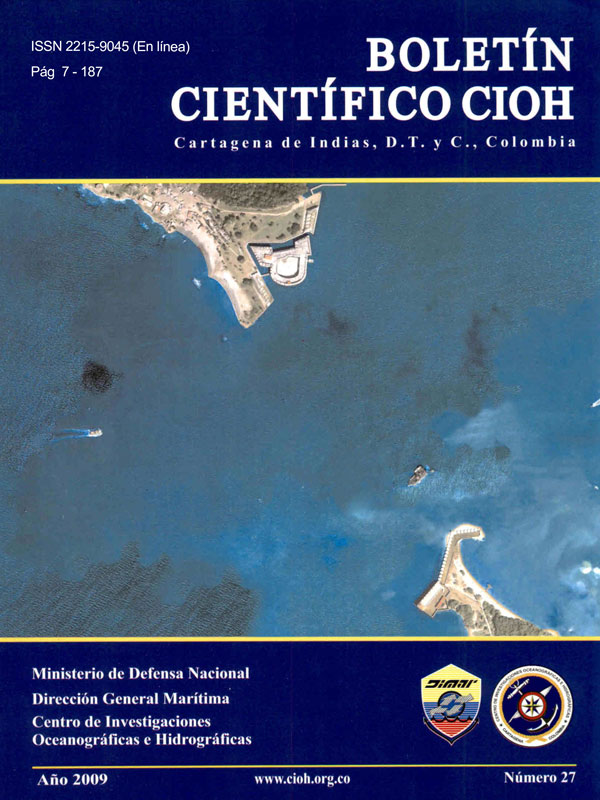Geodatabase model in storage and structuring of spatial information for management and control of the Caribbean Colombian Littoral
DOI:
https://doi.org/10.26640/22159045.206Keywords:
Geodatabase, structuration, spatial information, littoral, control and managementAbstract
In this research the results of using the data model called Geo-database in the structuring and storage of spatial information of the Cartagena de Indias littorals, the Tierra Bomba island, the Morrosquillo Gulf and between Tajamar Occidental of Magdalena river and Puerto Velero during the years 2007 and 2008 in the Colombian Caribbean are presented. The research included identification of the Maritime National Direction corporative Geodatabase requirements, verification of state and structuring of the spatial information obtained by the Oceanographic and Hydrographic Research Center and establishing the procedure for structuring and later storage of the information. The use of the geodatabase model in the study areas, permitted the structuring, storing and quantification of spatial information of 303.44 kilometers of coastline, 1512.31 hectares corresponding to beach areas and 10469.5 hectares of low tidal zones. This information will be used by the National Maritime Authority and its respective Port authorities as technical support for the control, administration and preservation of these govern property located on the Colombian Caribbean littoral.Downloads
References
[2] Briggs R. Data Types and Structures using ArcCatalog. Applied GIS Course. Geodatabase. [Online]. 2009 [cited 2009 April 29]. Available from: http://www.utdallas.edu/~briggs/poe6382/geodatabase.ppt.
[3] Grener S. SpatialDB Advisor. Independent Geospatial Solutions Architect. Technology Stack: The Geodatabase. [Online]. 2009 [cited 2009 April 28]. Available from: http://www.spatialdbadvisor.com/blog/46/radius-studio-and-esri-part-2/.
[4] Kalman N, Hogle I, Viers J. Designing a geodatabase for your project: Awetlands delineation example. Information Center for the Environment. University of California, Davis; 2004.
[5] North Dakota Geographic InformationSystems. Implementing Geodatabase Technology. [Online]. 2008 [cited 20098 Mar 20]. Available from:http://www.nd.gov/gis/news/2004pres/cass.html.
[6] Moelering H. Real maps, virtual maps and interactive cartography. In: Spatial Statistics and models. Edited by Gary L. Gaile and Cort J. Willmott. Editorial Kluwer; 1984.
[7] Gómez J. Documentación e implementación del procedimiento técnico para almacenar en la Geodatabase corporativa de la DIMAR, la información perteneciente a la determinación técnica de la jurisdicción de la Dirección General Marítima en el litoral Caribe colombiano. Cartagena de Indias; 2007.
[8] Instituto Colombiano de Normas Técnicas y Certificación. Norma Técnica Colombiana NTC 5043: Información geográfica conceptos básicos de calidad. Bogotá. 2002.
[9] Pollock R. Development of a geodatabase supporting community-based resource management strategies in Hawaii. Hawaii Coastal Zone Management Program and Statewide GIS rdProgram. Proceedings of the 3Biennial Coastal GeoTools Conference; 2003.
[10] Dadisman S, Flocks J, Calderón K. LASED Geodatabase: Atool to manage, analyze, distribute and archive geologic data from the Lousiana Costal Zone; 2004.
[11] Mc Fadden L, Vafeidis A, Nicholls R. A coastal database for thglobal impact and vulnerability analysis. Proceedings of the 5International Symposium on Coastal Engineering and Science of Coastal Sediment Preocesses: Coastal Sediments'03; 2003.
[12] Carvalho A, Fitzpatrick K, Kostura H. Streamlining Coastal Monitoring Programs with GIS in Martin County, Florida. Proceedings of the 23nd Annual ESRI international User Conference; 2003.
[13] Barnolas M, Llasat M. C. Aflood geodatabase and its climatological applications: the case of Catalonia for the last century. Natural Hazards and Earth Systems Sciences. 2007: 7: 271-281.
Downloads
Published
Issue
Section
License
Attribution — You must give appropriate credit, provide a link to the license, and indicate if changes were made. You may do so in any reasonable manner, but not in any way that suggests the licensor endorses you or your use.
NonCommercial — You may not use the material for commercial purposes.
NoDerivatives — If you remix, transform, or build upon the material, you may not distribute the modified material.
No additional restrictions — You may not apply legal terms or technological measures that legally restrict others from doing anything the license permits.



